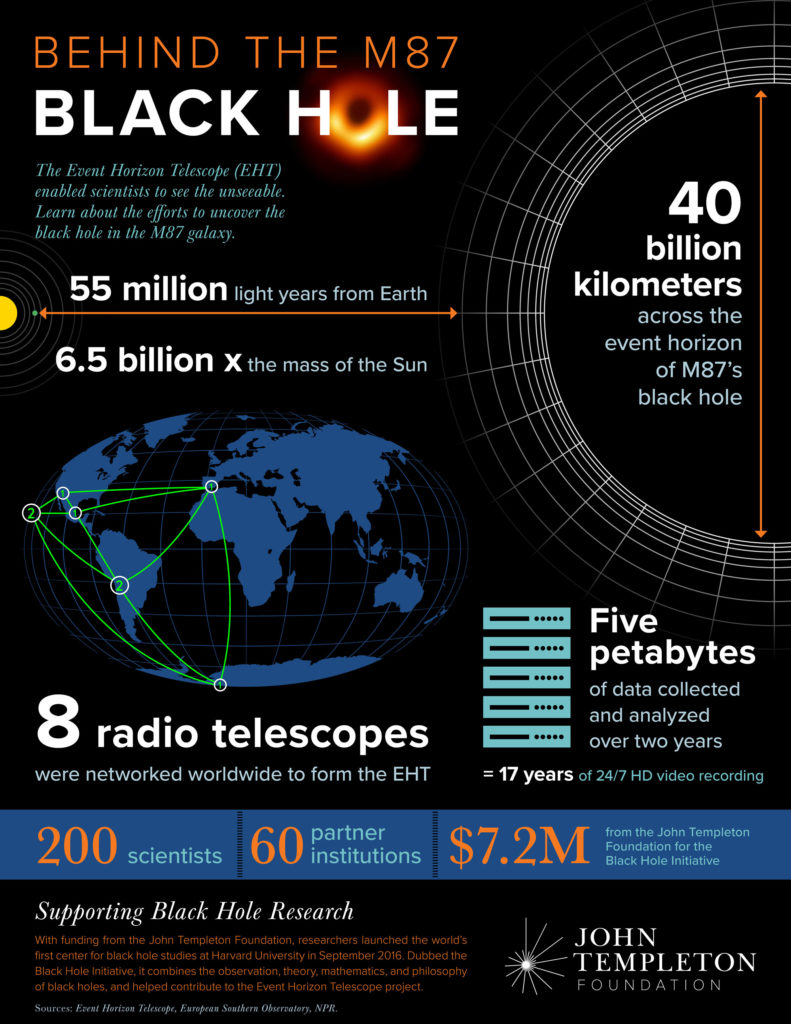In 2019, scientists revealed the first-ever image of a black hole’s event horizon. Now, look behind the scenes at the amazing work that went into its creation. In collaboration with Freethink Media, the John Templeton Foundation has produced a video around the question “What’s inside a black hole?” featuring Harvard’s Astronomy Chair, Dr. Avi Loeb, of the Black Hole Initiative, which received a $7.2 million grant from the Foundation in 2016.
Following this initial project, the John Templeton Foundation has awarded the Black Hole Initiative with an additional $3.6 million grant to continue its groundbreaking efforts over the next three years. This collaborative enterprise brings together scholars of diverse disciplines including astronomers, computer scientists, and plasma physicists as well as philosophers and filmmakers. Curious how this dynamic team embraces the challenges and benefits of interdisciplinary dialogue? Watch the full video here:
What Does a Black Hole Look Like?
How the First Picture of a Black Hole Was Taken
BLACK HOLE IMAGE: THE BLACK HOLE INITIATIVE
Scientific discoveries on the physical and symbolic scale of the black hole images are years in the making. Doeleman said that planning for the EHT began a decade ago, and the project eventually involved over 200 scientists from 60 institutes in more than 20 countries. Harvard’s Black Hole Initiative, which launched in 2016 with $7.2 million in funding from the John Templeton Foundation, served as a command center for the EHT project.
“We are delighted and honored that our philanthropic support has helped to enable the breakthrough seen today,” said Heather Templeton Dill, president of the John Templeton Foundation. “It’s an exciting new chapter in our work to foster discoveries in the natural sciences, and to spur reflection on the most profound questions facing humankind.”
Matthew Walhout, the foundation’s vice president for the natural sciences, agreed. “We’re proud to have supported this important work, which has confirmed the once radical-sounding predictions of Einstein’s theories,” he said. “This major discovery is just one result made possible through the foundation’s work to enable physicists and philosophers to collaborate to address fundamental questions on the nature of black holes.”
BLACK HOLE IMAGE: DATA’S LONG JOURNEY
The observations used to generate the images were taken in April of 2017, when the sophisticated equipment was finally in place and the weather cooperated at the telescope sites in Chile, Arizona, Spain, Hawaii, Mexico, and the South Pole. More than five petabytes of data were recorded on hard drives at the sites and flown to central processing facilities, where the data was be filtered to separate the signal from the noise. Since visible-wavelength light from the event horizon is absorbed by the gas clouds surrounding M87’s galactic center, the team focused on the one-millimeter wavelength — a few of those photons survived the 55 million-light-year journey from the black hole to Earth’s surface. EHT co-investigator Dan Marrone said that the data was simultaneously analyzed by four independent imaging teams, each of which used different algorithmic approaches to process the image. When the teams came together last summer, “What we saw in those images were four very similar pictures, looking almost exactly like the one you see today,” Marrone said. “It was a wonderful day for science.”
The final combined image is visually stunning, but in some ways its significance may be that it was more or less what the researchers had expected to see. Astrophysicist Avery Broderick, who introduced the EHT group’s preliminary interpretive findings, said that predictions based on Einstein’s theory of general relativity suggested that the event horizon shadow would be within 10 percent of a perfect circle. “When we began this expedition, we didn’t know what we would find,” Broderick said. “Today general relativity has passed another crucial test.”
Theoretical astrophysicist Sera Markoff, who offered reflections on the broader implications of the black hole image, noted that it tells us a lot about what different black holes have in common and how they might differ. “General relativity does not change with different black hole masses, but the impact will change a lot,” Markoff said. Using the shadow image, the EHT team determined that M87’s mass is equivalent to 6.5 billion suns. That result resolves a longstanding controversy about the black hole’s mass and now allows indirect measures of the mass to be calibrated with the observed data. “This will lead to better mass determinations for other more distant black holes where we can’t actually see the shadow,” Markoff said.
ENHANCING THE IMAGE
The EHT team is now working to process data from another stellar target, the dormant black hole Sagittarius A* (pronounced “A star”), which sits at the center of our own galaxy, the Milky Way. It is far closer than M87 — a mere 26,000 light years away — but is much harder to see because it is smaller and less active. The EHT’s imaging power is being increased as new telescopes are added to its network and data for even shorter wavelengths is gathered, paving the way for detailed observations about the extreme physical processes that occur around different types of black holes. “As with all great discoveries,” Doeleman said, “this is just the beginning.”
STILL CURIOUS?
Learn more about the Black Hole Initiative here.
See the remarkable first-ever picture of a black hole taken by a team including the Black Hole Initiative here and here.
Learn more about the John Templeton Foundation’s funding in Mathematics and Physical Sciences.
Explore grants in the philosophy of cosmology and read a research survey of efforts to investigate foundational questions in cosmology.
